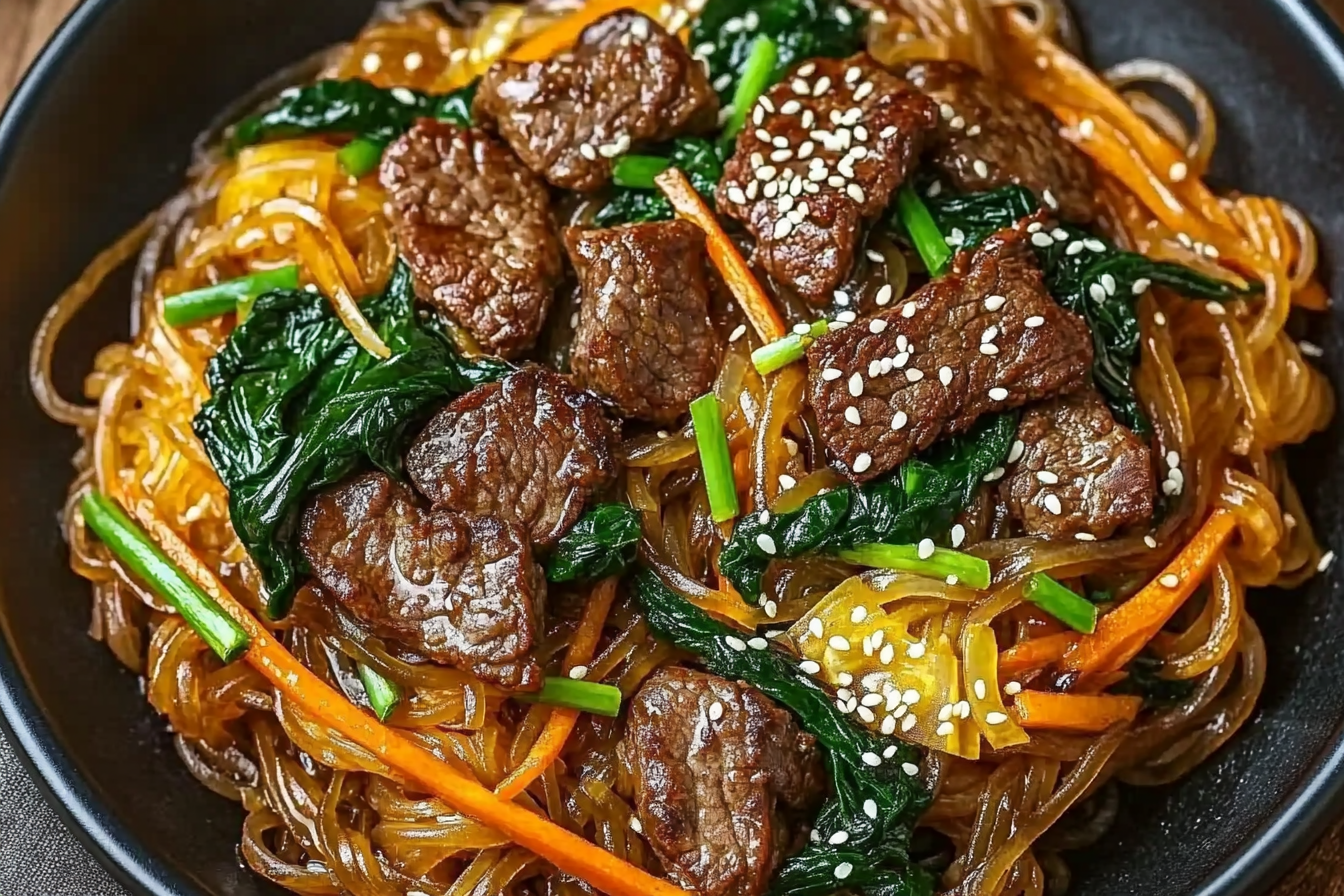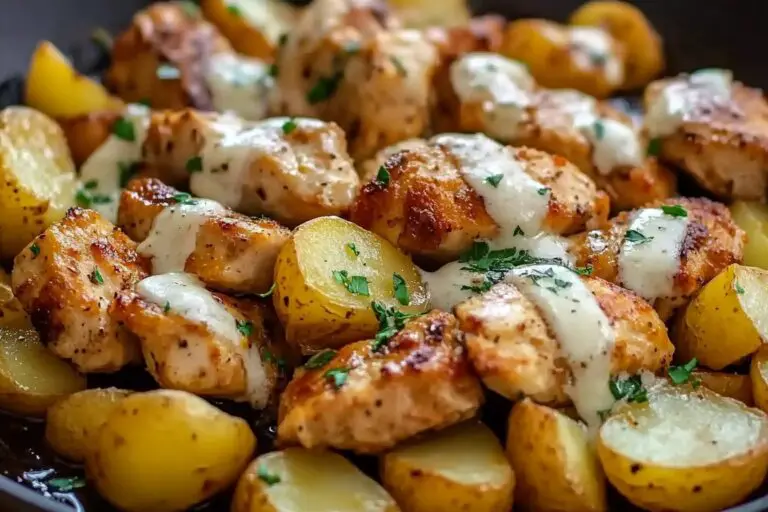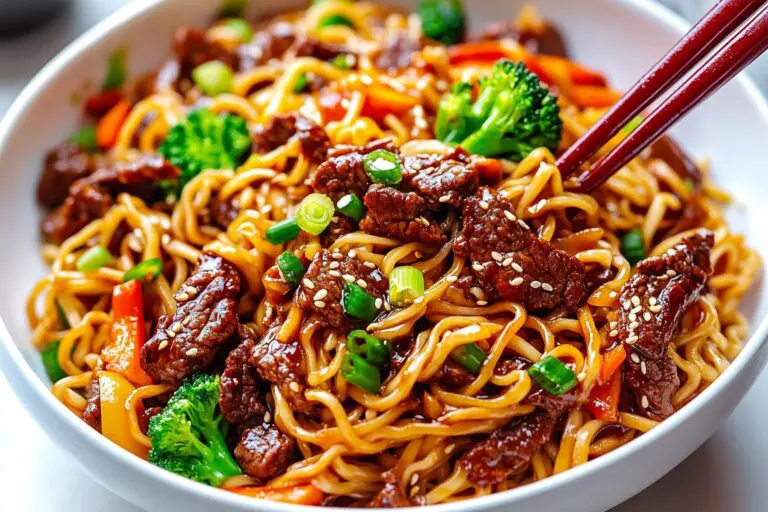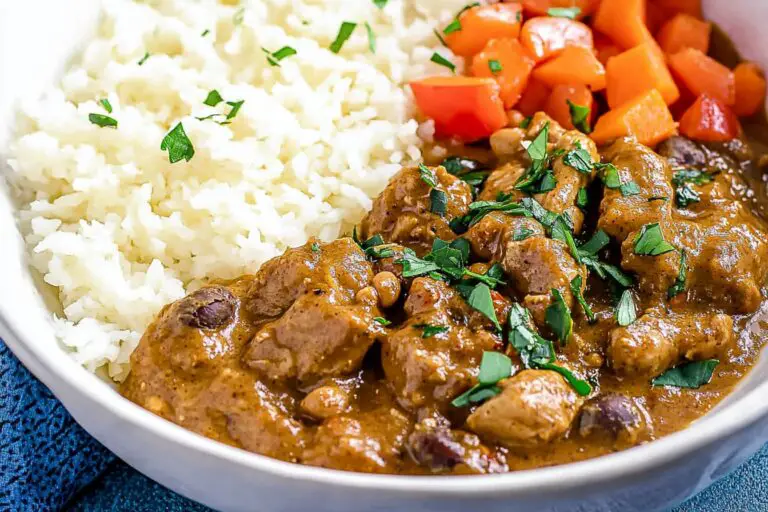Japchae Noodle Stir-Fry
Introduction
Japchae, a traditional Korean dish, is a stir-fried noodle dish made with sweet potato starch noodles, vegetables, and sometimes meat. Known for its delightful balance of flavors and textures, Japchae is often served at celebrations and special occasions in Korea. This versatile dish can be enjoyed as a main course or a side dish, making it a favorite among many.
Detailed Ingredients with measures
Sweet potato starch noodles: 200 grams
Vegetable oil: 2 tablespoons
Garlic: 2 cloves, minced
Carrot: 1 medium, julienned
Onion: 1 medium, thinly sliced
Spinach: 2 cups, blanched
Bell peppers: 1 cup, thinly sliced (use any color)
Mushrooms: 1 cup, sliced (shiitake or button)
Soy sauce: 3 tablespoons
Sugar: 1 tablespoon
Sesame oil: 1 tablespoon
Sesame seeds: 1 tablespoon, toasted
Green onions: 2, chopped (for garnish)
Ground beef or chicken (optional): 100 grams, sliced thinly
Prep Time
30 minutes
Cook Time, Total Time, Yield
Cook Time: 15 minutes
Total Time: 45 minutes
Yield: 4 servings
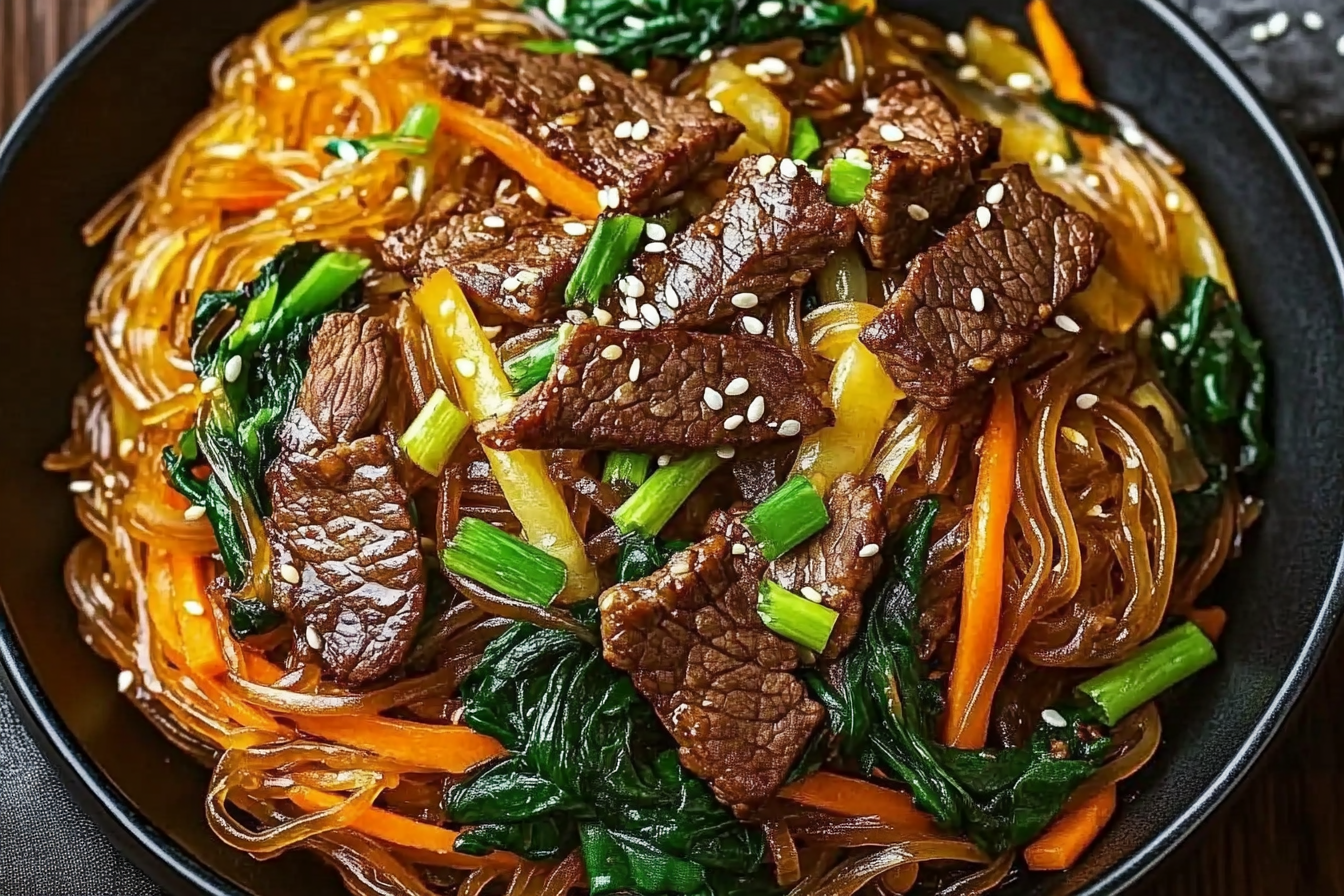
Detailed Directions and Instructions
Prepare the Ingredients
Start by gathering all the necessary ingredients for the Japchae. This includes sweet potato noodles, various vegetables, soy sauce, and sesame oil.
Cook the Noodles
Boil water in a pot and add the sweet potato noodles. Cook according to the package instructions until they are chewy and tender. Drain and set aside.
Prepare the Vegetables
While the noodles are cooking, wash and slice the vegetables. Common choices include carrots, bell peppers, spinach, and onions.
Sauté the Vegetables
In a large pan or wok, heat some oil over medium heat. Add the sliced carrots and onions first, cooking until they soften. Then, add the bell peppers and spinach, and sauté until all the vegetables are cooked through but still vibrant.
Add the Noodles
Once the vegetables are ready, add the drained sweet potato noodles to the pan. Mix well to combine all the ingredients.
Season the Dish
Pour in the soy sauce and sesame oil. Toss everything together, ensuring the noodles and vegetables are well-coated with the sauce.
Finish and Serve
Cook for an additional 2-3 minutes to warm everything through. Transfer the Japchae to a serving dish and garnish with sesame seeds if desired. Serve hot.
Notes
Ingredient Variations
Feel free to mix and match vegetables based on your preference or what you have available. Common additions can include shiitake mushrooms and zucchini.
Gluten-Free Option
To make a gluten-free version, ensure you use gluten-free soy sauce or tamari instead of regular soy sauce.
Storage Instructions
Leftover Japchae can be stored in an airtight container in the refrigerator for up to 3 days. Reheat gently before serving.
Serving Suggestions
Japchae pairs well with a variety of dishes, including grilled meats or can be enjoyed as a standalone meal.
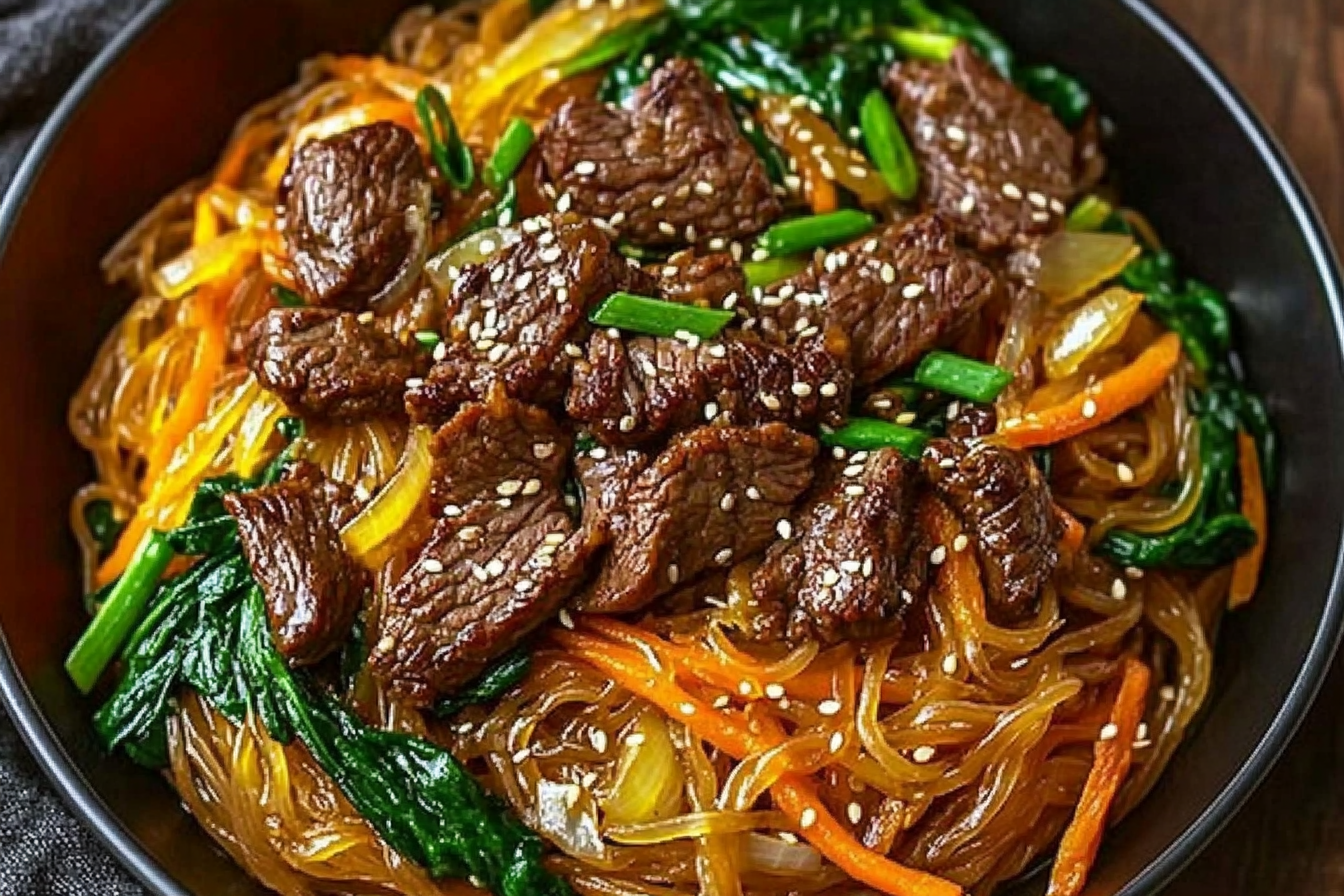
Cook techniques
Stir-frying
Stir-frying is a quick cooking method that helps to retain the color and flavor of the ingredients. It involves cooking food over high heat in a small amount of oil, stirring constantly to prevent it from sticking or burning.
Soaking noodles
Soaking the sweet potato noodles before cooking softens them and prepares them for stir-frying. Ensure they are fully submerged in warm water for the best results.
Seasoning
Proper seasoning is crucial for enhancing the flavors of the dish. Use soy sauce, sesame oil, and other spices to complement the ingredients without overpowering them.
Preparation of vegetables
Slice vegetables into uniform pieces to ensure even cooking. This technique helps maintain the texture and appearance of the dish.
Controlling cooking time
Adjusting the cooking time for each ingredient allows you to achieve the desired texture, ensuring that vegetables remain crisp while noodles are tender.
FAQ
What type of noodles is used in Japchae?
Japchae traditionally uses sweet potato noodles, known for their chewy texture.
Can I customize the vegetables in Japchae?
Yes, you can customize the vegetables based on your preferences or seasonal availability.
Is Japchae gluten-free?
If made with gluten-free soy sauce, Japchae can be gluten-free; however, confirm all ingredients before serving.
Can I make Japchae ahead of time?
Yes, Japchae can be made ahead of time and stored in the refrigerator. Reheat before serving.
What dishes pair well with Japchae?
Japchae pairs well with Korean BBQ, rice, or can be served as a standalone dish.
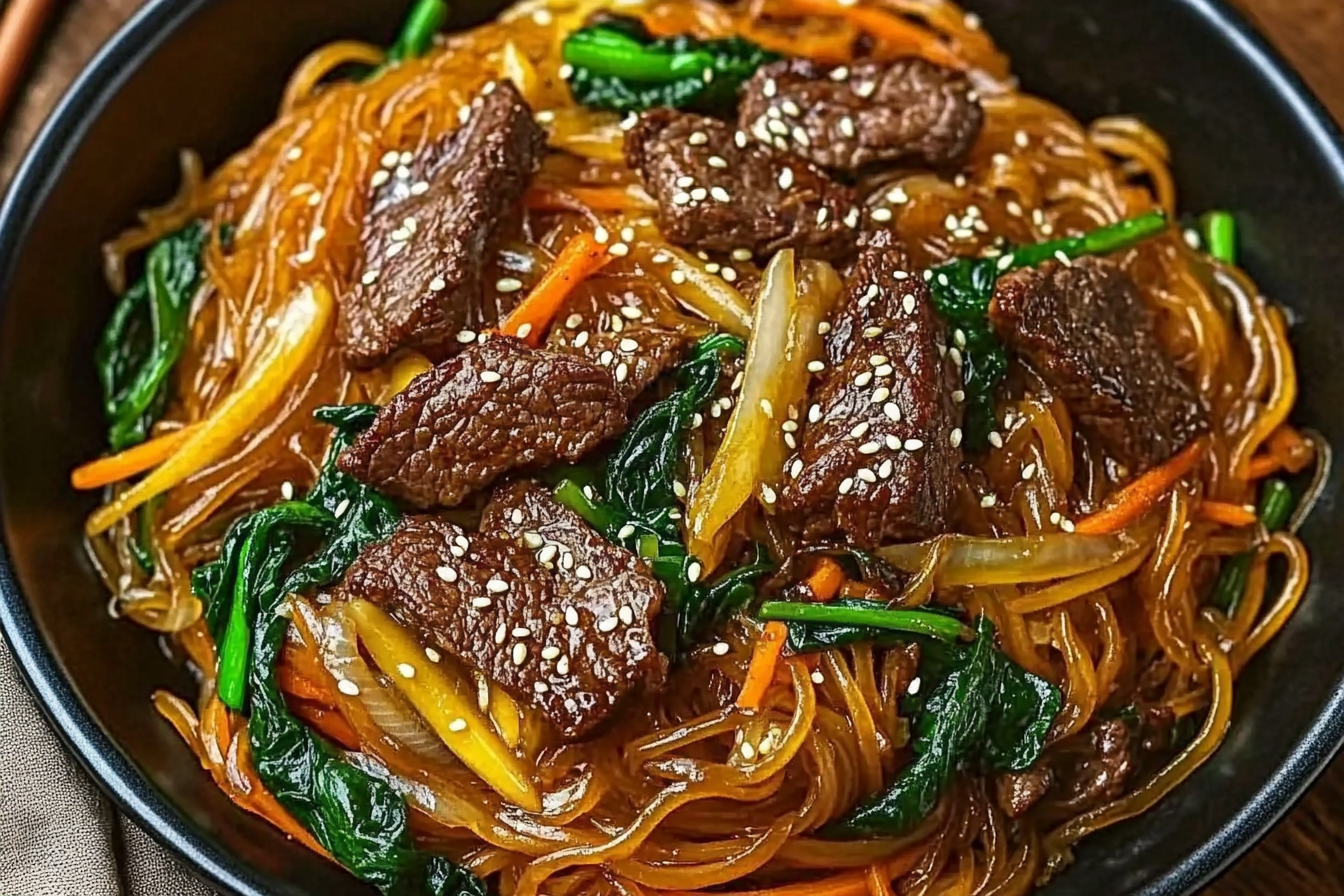
Conclusion
Japchae is a delicious and versatile Korean dish that can be easily customized with your choice of ingredients. Its unique combination of sweet potato noodles, vegetables, and protein makes it a delightful meal that caters to a variety of tastes. Whether enjoyed warm or cold, japchae is perfect for any occasion, from family dinners to special celebrations.
More recipes suggestions and combination
Vegetable Japchae
Try making a vegetarian version by using an array of colorful vegetables such as bell peppers, carrots, and mushrooms, paired with the sweet potato noodles.
Beef Japchae
Add marinated beef strips for a heartier meal. The savory flavor of the beef enhances the overall taste of the dish.
Shrimp Japchae
Incorporate shrimp for a seafood twist. The sweetness of the shrimp complements the noodles and sauce beautifully.
Chicken Japchae
Use chicken as the main protein and blend it with a mix of your favorite seasonal vegetables for added flavor and nutrition.
Spicy Japchae
Elevate the flavor profile by adding gochujang (Korean chili paste) for a spicy kick that tantalizes the taste buds.
Japchae Salad
For a refreshing option, serve japchae cold as a salad topped with sesame seeds and fresh herbs.
Japchae Spring Rolls
Wrap japchae in rice paper to create delicious spring rolls that are perfect for appetizers or snacks.
Japchae Stir-fry
Incorporate japchae into a stir-fry with additional proteins and vegetables for a quick and satisfying meal.
Sweet and Sour Japchae
Add a tangy sauce for a sweet and sour twist that adds an exciting flavor dimension to the classic dish.

